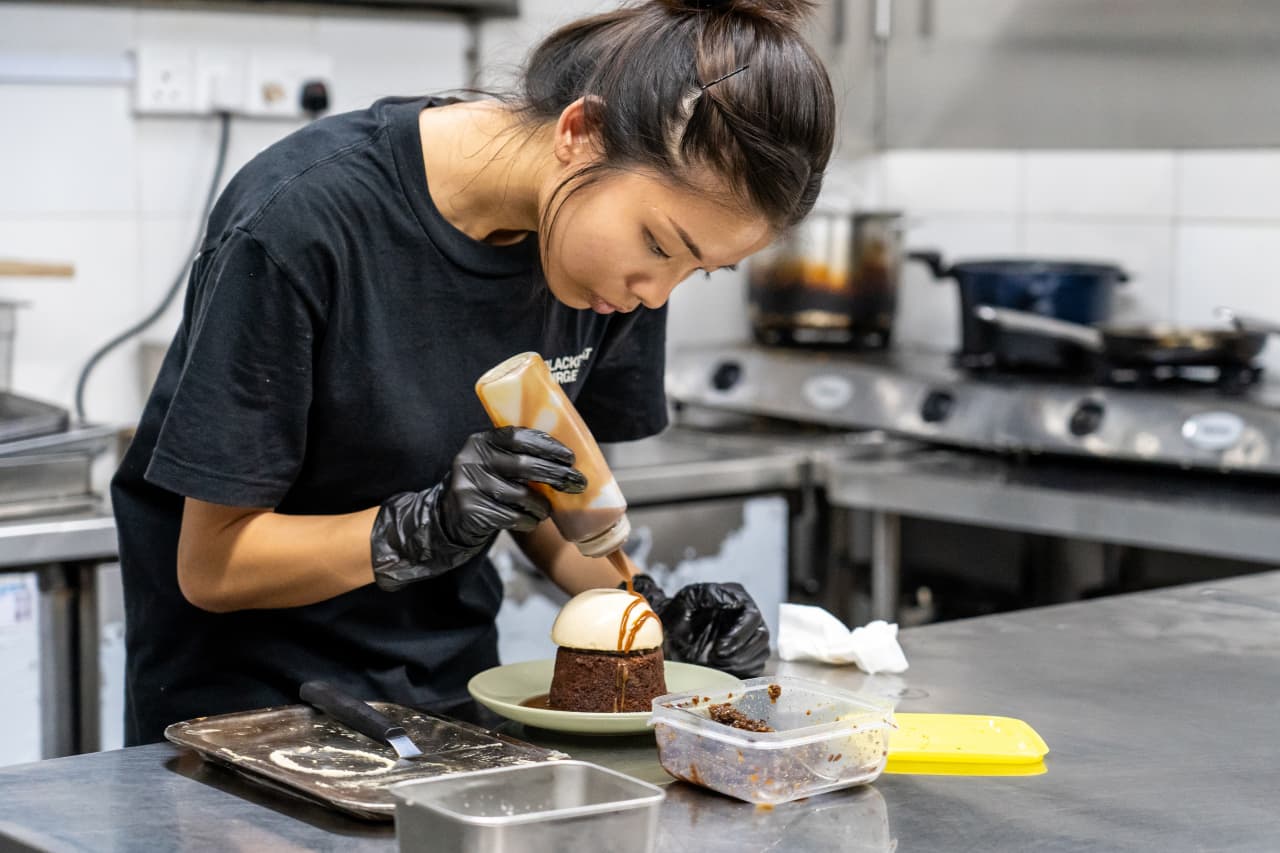One of the largest names in the ski world is taking steps to make the industry more sustainable.
“The outdoors is our business,” says Kate Wilson, vice president of environmental and social responsibility at Vail Resorts.
Vail Resorts, a mountain resort company with a network of 41 ski resorts across four countries, set out to make a major commitment to their sustainability efforts in 2017. The intent was to achieve a net-zero operating footprint by 2030. This “Commitment to Zero” includes the ambitious goal of zero net emissions, zero waste to landfill, and zero net operating impact on forests and habitat.
“On day one, we didn’t have the road maps and plans on how we were going to get there, but we’ve since built those,” Wilson says. “And we’ve brought others in the industry with us.”
Just six years later, Vail Resorts is ahead of schedule to reach its emissions goals and on track to achieve the zero net operating footprint by 2030. The company reached 100% renewable electricity for the second year and hit its 2030 energy-efficiency target early.
Offsets are another way Vail Resorts is supporting sustainability. They have reforested over 200 acres of land since 2017 and support wind farms across the country. Plum Creek is a large-scale wind farm enabled by Vail Resorts. In its 2023 fiscal year, it produced 350,177 megawatt hours of renewable electricity, equivalent to the electricity needed to power 48,286 homes for one year.
“Sustainability and the way it is integrated into our business and operationalised with every decision that we make is something I’m really proud of,” Wilson says. “We’re not just thinking about how we, as a resort, can make an impact on climate change but how we can use our voice across our resorts, our industry, and beyond.”
Commitment to Zero gives the Vail Resorts properties one central sustainability focus. With one common goal, the company can lean into and take advantage of their enterprise network.
“At every resort we’re sharing lessons learned: ‘We did this thing in Whistler, we should do it in Park City,’” Wilson says. “That’s the power of the network and coming together to say, ‘what can we do that’s bigger than each of our resorts?’”
To further that goal of sharing lessons and ideas, Vail Resorts spearheaded The Mountain Collaborative for Climate Action in 2019. Now with over 76 resorts in the collaborative, the group works together on innovative solutions to help spread sustainability across the ski industry. Vail Resorts also partners with the National Ski Areas Association on quarterly meetings to discuss items related to green initiatives and share its experiences with an even larger group.
“There are smaller resorts that don’t have sustainability resources. We can share lessons learned, come up with solutions where we tell them, for example, how we recycle our nitrile gloves and turn them into pellets that become playgrounds,” explains Wilson. “We don’t need to own these things we want to share with others so they can take action, too.”
Developing innovative solutions for recycling and reducing landfill waste is a key part of this sustainability strategy. Initiatives to collect and upcycle waste can be easily replicated at multiple resorts. A project to collect and recycle soft plastics into decking is being piloted at various properties across the Vail Resorts mountains.
Other innovative solutions Vail Resorts has implemented include the ski industry’s only gondola-based waste removal system, a custom-designed recycling center at Vail Mountain, and a resource-efficient snowmaking system.
Vail Resorts also leans on strategic partners to assist with their green efforts. The company worked with PepsiCo, their on-mountain beverage partner, to develop a program to upcycle candy and snack wrappers into furniture and terrain park features. There’s now a Mountain Dew wallride in the terrain park at Breckenridge crafted from recycled bottles and snack packaging materials.
The company also joined together with Helly Hansen to turn old ski resort work uniforms into tote bags and ski patrol backpacks. The products were sold on behalf of their EpicPromise Employee Foundation, which provides hardship and education grants to teammates.
The employee foundation is one way Vail Resorts is expanding its efforts beyond environmental initiatives. The company has a large youth access program and hosted more than 11,000 youths across 32 properties in the 2022-23 season, according to the resort.
“We really believe the future of the sport is inclusion. We care deeply about removing some of those barriers to have people try the sport for the first time,” Wilson says.
 Copyright 2020, Dow Jones & Company, Inc. All Rights Reserved Worldwide. LEARN MORE
Copyright 2020, Dow Jones & Company, Inc. All Rights Reserved Worldwide. LEARN MORE
What a quarter-million dollars gets you in the western capital.
Alexandre de Betak and his wife are focusing on their most personal project yet.
No trip to Singapore is complete without a meal (or 12) at its hawker centers, where stalls sell multicultural dishes from generations-old recipes. But rising costs and demographic change are threatening the beloved tradition.
In Singapore, it’s not unusual for total strangers to ask, “Have you eaten yet?” A greeting akin to “Good morning,” it invariably leads to follow-up questions. What did you eat? Where did you eat it? Was it good? Greeters reserve the right to judge your responses and offer advice, solicited or otherwise, on where you should eat next.
Locals will often joke that gastronomic opinions can make (and break) relationships and that eating is a national pastime. And why wouldn’t it be? In a nexus of colliding cultures—a place where Malays, Indians, Chinese and Europeans have brushed shoulders and shared meals for centuries—the mix of flavours coming out of kitchens in this country is enough to make you believe in world peace.
While Michelin stars spangle Singapore’s restaurant scene , to truly understand the city’s relationship with food, you have to venture to the hawker centres. A core aspect of daily life, hawker centres sprang up in numbers during the 1970s, built by authorities looking to sanitise and formalise the city’s street-food scene. Today, 121 government-run hawker centres feature food stalls that specialise in dishes from the country’s various ethnic groups. In one of the world’s most expensive cities, hawker dishes are shockingly cheap: A full meal can cost as little as $3.
Over the course of many visits to Singapore, I’ve fallen in love with these places—and with the scavenger hunts to find meals I’ll never forget: delicate bowls of laksa noodle soup, where brisk lashes of heat interrupt addictive swirls of umami; impossibly flaky roti prata dipped in curry; the beautiful simplicity of an immaculately roasted duck leg. In a futuristic and at times sterile city, hawker centres throw back to the past and offer a rare glimpse of something human in scale. To an outsider like me, sitting at a table amid the din of the lunch-hour rush can feel like glimpsing the city’s soul through all the concrete and glitz.
So I’ve been alarmed in recent years to hear about the supposed demise of hawker centres. Would-be hawkers have to bid for stalls from the government, and rents are climbing . An upwardly mobile generation doesn’t want to take over from their parents. On a recent trip to Singapore, I enlisted my brother, who lives there, and as we ate our way across the city, we searched for signs of life—and hopefully a peek into what the future holds.
At Amoy Street Food Centre, near the central business district, 32-year-old Kai Jin Thng has done the math. To turn a profit at his stall, Jin’s Noodle , he says, he has to churn out at least 150 $4 bowls of kolo mee , a Malaysian dish featuring savoury pork over a bed of springy noodles, in 120 minutes of lunch service. With his sister as sous-chef, he slings the bowls with frenetic focus.
Thng dropped out of school as a teenager to work in his father’s stall selling wonton mee , a staple noodle dish, and is quick to say no when I ask if he wants his daughter to take over the stall one day.
“The tradition is fading and I believe that in the next 10 or 15 years, it’s only going to get worse,” Thng said. “The new generation prefers to put on their tie and their white collar—nobody really wants to get their hands dirty.”
In 2020, the National Environment Agency , which oversees hawker centres, put the median age of hawkers at 60. When I did encounter younger people like Thng in the trade, I found they persevered out of stubbornness, a desire to innovate on a deep-seated tradition—or some combination of both.
Later that afternoon, looking for a momentary reprieve from Singapore’s crushing humidity, we ducked into Market Street Hawker Centre and bought juice made from fresh calamansi, a small citrus fruit.
Jamilah Beevi, 29, was working the shop with her father, who, at 64, has been a hawker since he was 12. “I originally stepped in out of filial duty,” she said. “But I find it to be really fulfilling work…I see it as a generational shop, so I don’t want to let that die.” When I asked her father when he’d retire, he confidently said he’d hang up his apron next year. “He’s been saying that for many years,” Beevi said, laughing.
More than one Singaporean told me that to truly appreciate what’s at stake in the hawker tradition’s threatened collapse, I’d need to leave the neighbourhoods where most tourists spend their time, and venture to the Heartland, the residential communities outside the central business district. There, hawker centres, often combined with markets, are strategically located near dense housing developments, where they cater to the 77% of Singaporeans who live in government-subsidised apartments.
We ate laksa from a stall at Ghim Moh Market and Food Centre, where families enjoyed their Sunday. At Redhill Food Centre, a similar chorus of chattering voices and clattering cutlery filled the space, as diners lined up for prawn noodles and chicken rice. Near our table, a couple hungrily unwrapped a package of durian, a coveted fruit banned from public transportation and some hotels for its strong aroma. It all seemed like business as usual.
Then we went to Blackgoat . Tucked in a corner of the Jalan Batu housing development, Blackgoat doesn’t look like an average hawker operation. An unusually large staff of six swirled around a stall where Fikri Amin Bin Rohaimi, 24, presided over a fiery grill and a seriously ambitious menu. A veteran of the three-Michelin-star Zén , Rohaimi started selling burgers from his apartment kitchen in 2019, before opening a hawker stall last year. We ordered everything on the menu and enjoyed a feast that would astound had it come out of a fully equipped restaurant kitchen; that it was all made in a 130-square-foot space seemed miraculous.
Mussels swam in a mushroom broth, spiked with Thai basil and chives. Huge, tender tiger prawns were grilled to perfection and smothered in toasted garlic and olive oil. Lamb was coated in a whisper of Sichuan peppercorns; Wagyu beef, in a homemade makrut-lime sauce. Then Ethel Yam, Blackgoat’s pastry chef prepared a date pudding with a mushroom semifreddo and a panna cotta drizzled in chamomile syrup. A group of elderly residents from the nearby towers watched, while sipping tiny glasses of Tiger beer.
Since opening his stall, Rohaimi told me, he’s seen his food referred to as “restaurant-level hawker food,” a categorisation he rejects, feeling it discounts what’s possible at a hawker centre. “If you eat hawker food, you know that it can often be much better than anything at a restaurant.”
He wants to open a restaurant eventually—or, leveraging his in-progress biomedical engineering degree, a food lab. But he sees the modern hawker centre not just as a steppingstone, but a place to experiment. “Because you only have to manage so many things, unlike at a restaurant, a hawker stall right now gives us a kind of limitlessness to try new things,” he said.
Using high-grade Australian beef and employing a whole staff, Rohaimi must charge more than typical hawker stalls, though his food, around $12 per 100 grams of steak, still costs far less than high-end restaurant fare. He’s found that people will pay for quality, he says, even if he first has to convince them to try the food.
At Yishun Park Hawker Centre (now temporarily closed for renovations), Nurl Asyraffie, 33, has encountered a similar dynamic since he started Kerabu by Arang , a stall specialising in “modern Malay food.” The day we came, he was selling ayam percik , a grilled chicken leg smothered in a bewitching turmeric-based marinade. As we ate, a hawker from another stall came over to inquire how much we’d paid. When we said around $10 a plate, she looked skeptical: “At least it’s a lot of food.”
Asyraffie, who opened the stall after a spell in private dining and at big-name restaurants in the region, says he’s used to dubious reactions. “I think the way you get people’s trust is you need to deliver,” he said. “Singapore is a melting pot; we’re used to trying new things, and we will pay for food we think is worth it.” He says a lot of the same older “uncles” who gawked at his prices, are now regulars. “New hawkers like me can fill a gap in the market, slightly higher than your chicken rice, but lower than a restaurant.”
But economics is only half the battle for a new generation of hawkers, says Seng Wun Song, a 64-year-old, semiretired economist who delves into the inner workings of Singapore’s food-and-beverage industry as a hobby. He thinks locals and tourists who come to hawker centers to look for “authentic” Singaporean food need to rethink what that amorphous catchall word really means. What people consider “heritage food,” he explains, is a mix of Malay, Chinese, Indian and European dishes that emerged from the country’s founding. “But Singapore is a trading hub where people come and go, and heritage moves and changes. Hawker food isn’t dying; it’s evolving so that it doesn’t die.”















